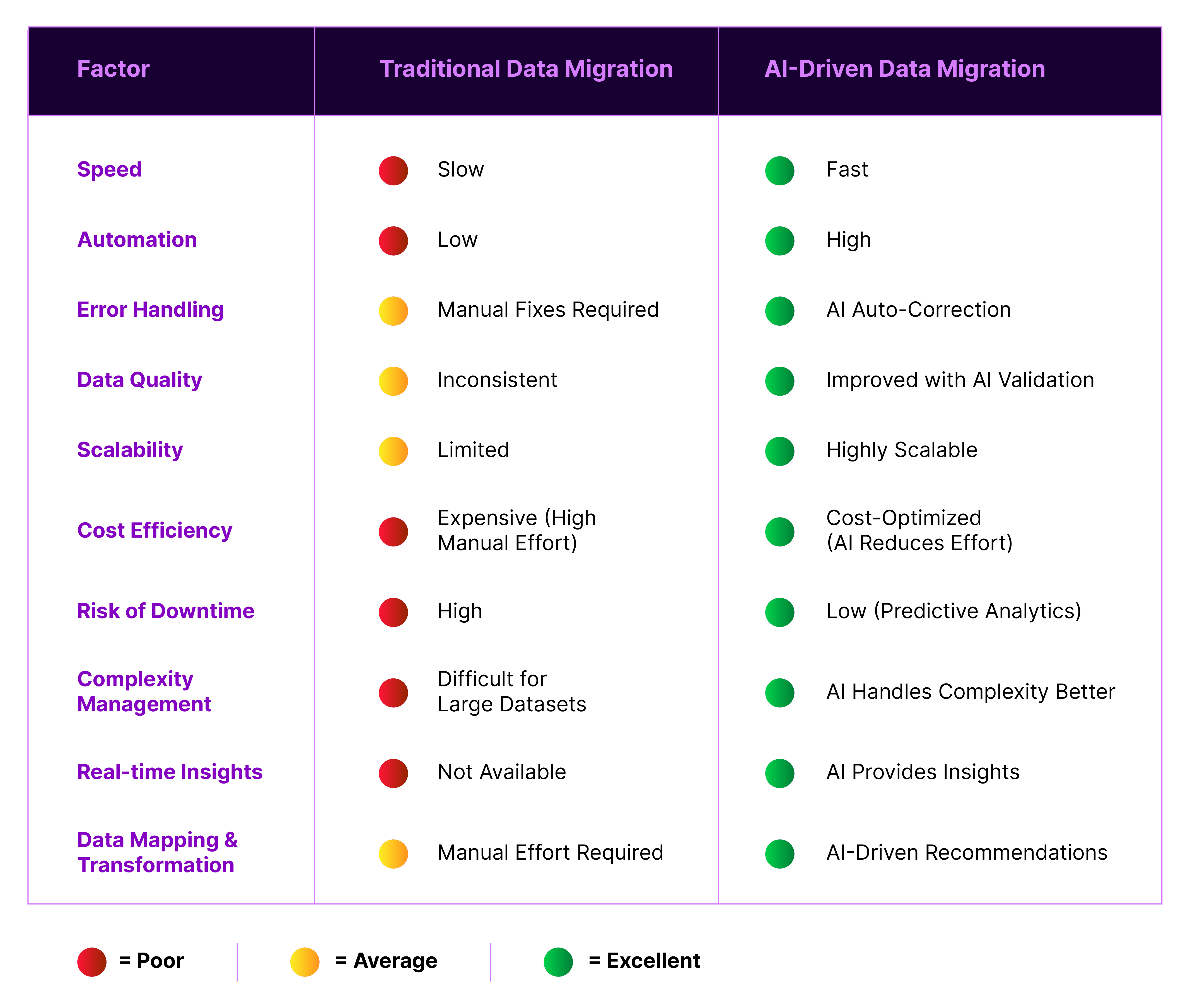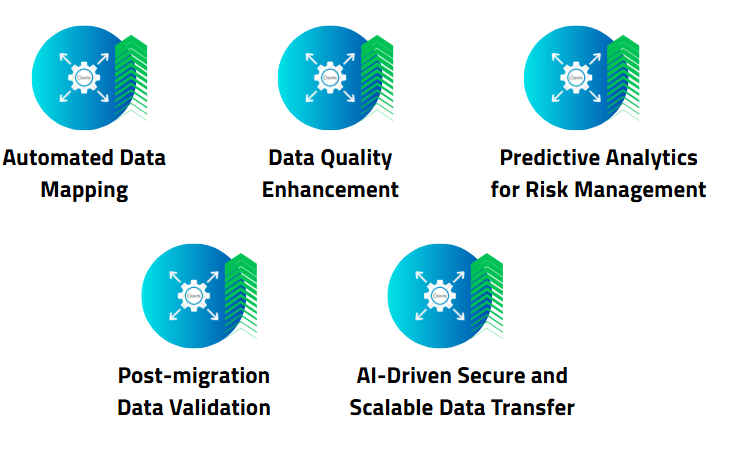
Imagine this: A global enterprise is struggling with slow, outdated systems, drowning in siloed data, and missing out on real-time analytics. The leadership team knows that digital transformation is the only way forward, but there’s one major roadblock—enterprise data migration. Moving years’ worth of critical data from legacy systems to the cloud is daunting.
Enter AI-powered data migration.
Gone are the days of manual, error-prone data transfers. Today, AI in data migration is revolutionizing how businesses modernize their infrastructure, ensuring a secure, scalable, and efficient transition to next-gen platforms. But how exactly does AI accelerate this shift? Let’s explore.
What is Data Migration?
Data migration is the process of transferring data from one system, storage, or format to another while ensuring its integrity, security, and accessibility. This process is essential when organizations upgrade legacy systems, move to the cloud, or consolidate databases.
Why Is It Critical for Digital Transformation?
In digital transformation, data migration plays a critical role by enabling businesses to adopt modern technologies, improve operational efficiency, and unlock the full potential of data-driven decision-making. Without a seamless migration strategy, organizations risk data loss, system downtime, and compatibility issues, which can hinder innovation and disrupt business continuity. A well-executed data migration ensures a smooth transition, empowering enterprises to leverage AI, analytics, and automation for future growth.
Reasons to choose AI-powered Data Migration vs Traditional Data Migration

How AI is Transforming Enterprise Data Migration
The integration of AI and machine learning in data migration is changing the game. From automated data mapping to secure data transfer, AI-powered solutions are ensuring faster, smarter, and risk-free migrations. Here’s how:

1. Automated Data Mapping
Gone are the days of painstakingly mapping data fields between different systems. AI revolutionizes data mapping by automatically detecting relationships, analyzing structures, and aligning datasets with precision. This eliminates manual errors, reduces inconsistencies, and accelerates the entire migration process. With AI-driven automation, businesses can seamlessly transform data without the risk of misalignment or costly delays.
“Nearly all IT organizations today — 98% — encounter obstacles in their digital transformation journeys. Among them, 80% point to data silos as a key issue, while 72% face difficulties due to overly interdependent systems.” ( Salesforce)
Before data makes its way to a new system, AI steps in to refine and enhance its quality. Machine learning algorithms scan datasets, identify anomalies, remove duplicates, and standardize formats, ensuring only clean, reliable information is migrated. This proactive approach boosts data governance, enhances compliance, and ensures business decisions are backed by accurate, high-quality data.
“The global AI in Data Quality market is projected to grow significantly, rising from USD 0.9 billion in 2023 to an estimated USD 6.6 billion by 2033” (market.us)
3. Predictive Analytics for Risk Management
What if you could predict migration failures before they happen? AI makes this possible by leveraging predictive analytics to identify potential bottlenecks, forecast risks, and suggest proactive solutions. By analyzing historical data and real-time migration metrics, AI helps businesses minimize disruptions, reduce downtime, and keep their data migration projects on track.
“A Case Study of Greece revealed that 77.9% of respondents view AI-driven analytics tools as essential to their strategic risk management planning, and 94.8% value the insights provided by AI-powered data analytics in their risk assessment processes. ” (MDPI)
4. Post-migration Data Validation
Migrating data is just one part of the journey—validating its accuracy post-migration is just as crucial. AI automates this process by comparing migrated data with source systems, flagging inconsistencies, and detecting anomalies in real time. This ensures businesses don’t face compliance issues, missing data, or operational disruptions.
“A study by Deloitte indicates that AI-powered migrations can decrease errors by up to 40% and speed up the migration process by 30%, confirming AI's reliability in improving data migration processes” (Deloitte)
5. AI-Driven Secure and Scalable Data Transfer
Data security is a top priority during migration, and AI ensures that data moves safely and efficiently. AI-driven encryption, real-time anomaly detection, and automated access controls protect sensitive information while optimizing transfer speeds. Whether businesses are handling terabytes or petabytes of data, AI enables seamless scalability without compromising security.
“Data Migration Market Size, which encompasses data transfer processes, is estimated to reach 25,200 Million by 2030, growing at a CAGR of 18.4% during the forecast period 2024-2030” (IndustryARC)
The Future of AI-Powered Data Migration
AI is rapidly transforming data migration, but this is just the beginning. As technology advances, AI-driven automation will take migrations to new heights, making them faster, smarter, and more secure than ever before. Here’s a glimpse into what the future holds:
Final Thoughts: Why ChainSys Is the Right Partner for AI-Driven Migration
When it comes to AI-powered data migration, ChainSys stands out as a trusted leader, delivering precision, speed, and security at every step. With our Smart Data Platform, businesses can confidently migrate their enterprise data with minimal risk and maximum efficiency.
Here’s why ChainSys is the right choice:
✅ AI-Driven Automation – Eliminates manual effort with intelligent data mapping, transformation, and validation.
✅ Seamless Integration – Real-time synchronization between legacy and modern systems ensures zero downtime.
✅ Predictive Analytics & Risk Mitigation – AI proactively detects potential issues before they impact operations.
✅ End-to-end Compliance & Security – Built-in governance tools ensure data integrity while meeting regulatory standards.
✅ Scalability for Enterprise Needs – Handles massive datasets with ease, making it ideal for large-scale cloud migrations.
Ready to accelerate your digital transformation with ChainSys? Contact us today for a demo, or download our eBook on AI-powered data migration best practices.